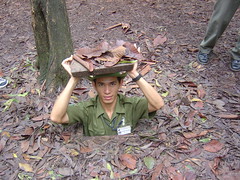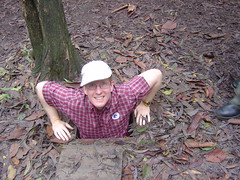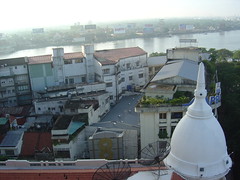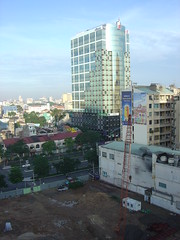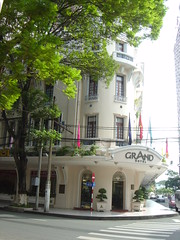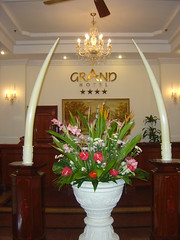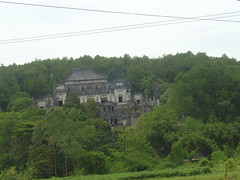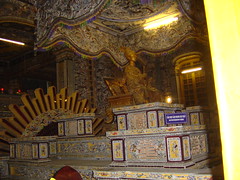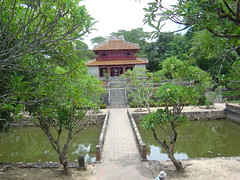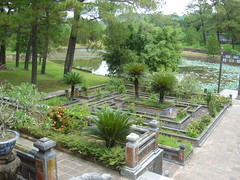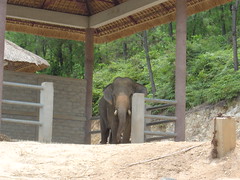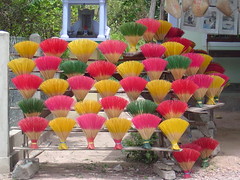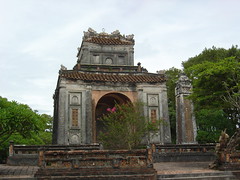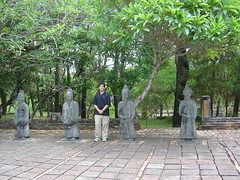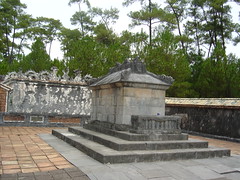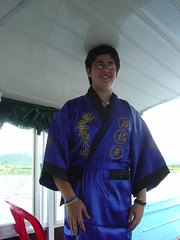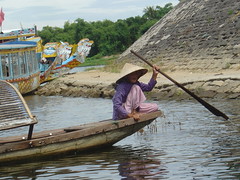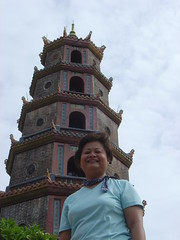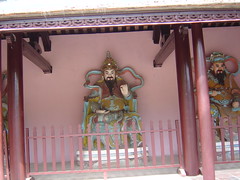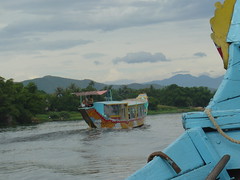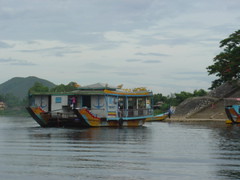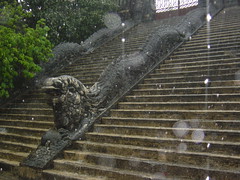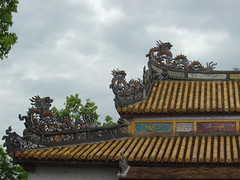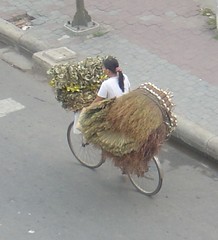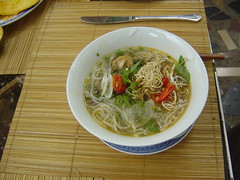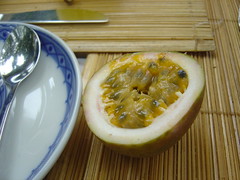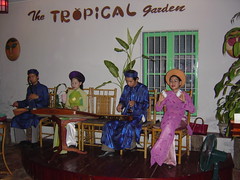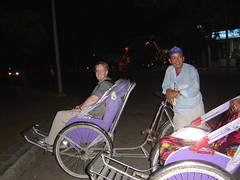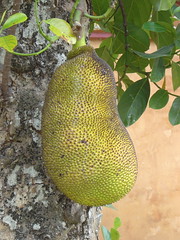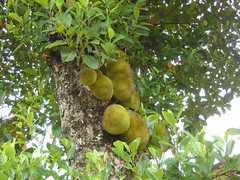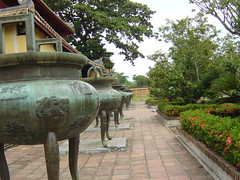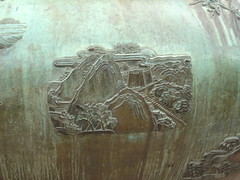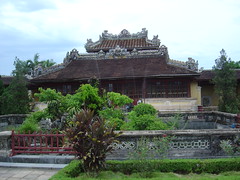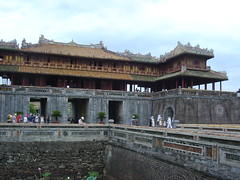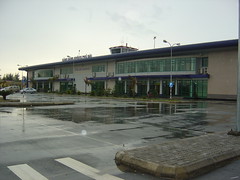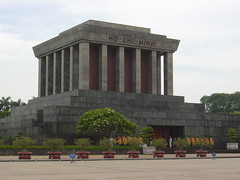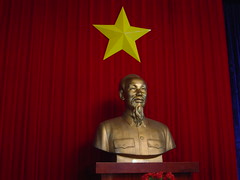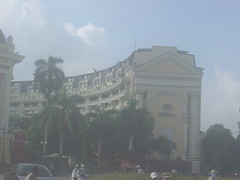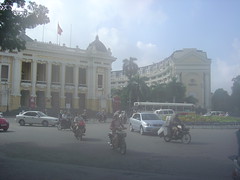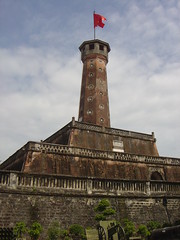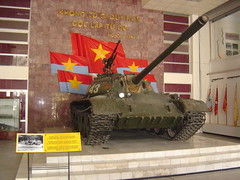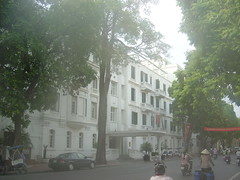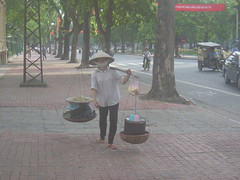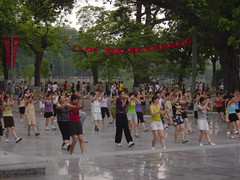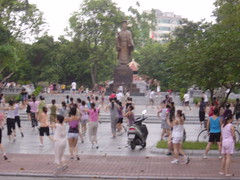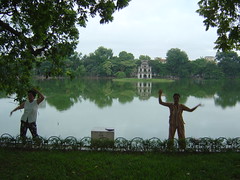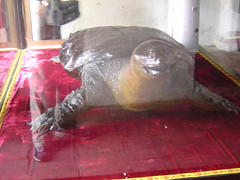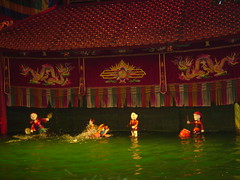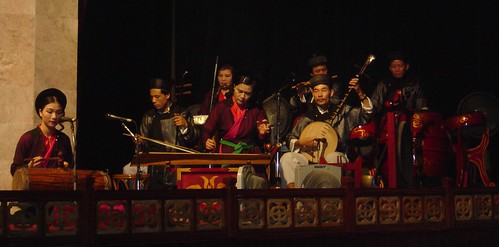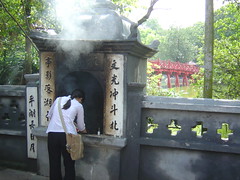The Cu Chi area just outside of Saigon was the center of Viet Cong activity during the war. As such, it was the subject of much military activity and the Viet Cong went to elaborate measures to hide from American soldiers.
One of the major methods was an elaborate tunnel complex that ran for literally hundreds of miles. In many cases, tunnels went up to and into American bases. Entrances into the tunnels were elaborately disguised and were so small that few American soldiers could enter them, even if they were found.
The Cu Chi tunnels are now a major tourist itnerary. Various parts of the Cu Chi area have been transformed into displays and exhibits about life for the Viet Cong soldiers and supporters. Tours are given by Army soldiers who demonstrate various parts of the tunnel system.
Before visiting the tunnels, a visitor center has a cut-away diorama of the complexity of the system, and tourists are shown a grainy vintage black and white movie praising the tanacity and dedication of the Viet Cong rebels. It was not subtle.
I was the only one of the Americans in our tour group willing to try to get into the tunnel. While I could just barely fit into the opening, when I crouched down, I got a minor panic attack. It took help from our guide to perform the rather gymnastic lift necessary to get out of the hole.
Other parts of the tour showed large craters from the constant aerial bombardment, different types and styles of pungee booby traps and pits, and all the various methods of concealing things like cooking smoke from detection.
There were also random pieces of destroyed military equipment on display and the opportunity to pose with cardboard cut-outs of black pajama clad insurgents. Please see my previous post here about my feelings about these types of displays.
Even accounting for differences in opinion over the war, it is hard to see the efforts of the Communist rebels and not be awed by their tenacity and ingenuity.
Wednesday, December 21, 2005
Monday, December 12, 2005
Room With A View
Our ninth floor room at the Grand Hotel in Saigon had great views of both the Saigon River and the city. In the first picture, the turret from the older part of the Grand Hotel (seen from the street in this picture) shows a series of low rise buildings near the waterfront. Immediately to the left as seen in this picture is the Rennaissance Saigon. Just to the right is another older hotel and another new high rise.
In a few years, I have to imagine that these older buildings will be demolished to make way for a new high rise that will probably block this great view of the river traffic up and down the Saigon River.
Across Dong Khoi street from the hotel there is a large construction site that is being billed as a multi-use high rise that was just starting. The construction noises woke us up pretty early one morning.
The pace of construction is Saigon is amazing and I fear a lot of the old character will be lost. While we were there a large department store opened further up Dong Khoi. Modeled after Japanese department stores, each floor specialized in a different area like women's clothes, electronics, and housewares. The top floor had a very nice food court and a huge gaming arcade that had videogames and bowling.
The prices were very high. Men's dress shirts were designer names and easily cost US$60 or more. Within walking distance on Dong Khoi, you can find tailor shops that will custom make clothes at a fraction of the cost. Times change.
In a few years, I have to imagine that these older buildings will be demolished to make way for a new high rise that will probably block this great view of the river traffic up and down the Saigon River.
Across Dong Khoi street from the hotel there is a large construction site that is being billed as a multi-use high rise that was just starting. The construction noises woke us up pretty early one morning.
The pace of construction is Saigon is amazing and I fear a lot of the old character will be lost. While we were there a large department store opened further up Dong Khoi. Modeled after Japanese department stores, each floor specialized in a different area like women's clothes, electronics, and housewares. The top floor had a very nice food court and a huge gaming arcade that had videogames and bowling.
The prices were very high. Men's dress shirts were designer names and easily cost US$60 or more. Within walking distance on Dong Khoi, you can find tailor shops that will custom make clothes at a fraction of the cost. Times change.
Tuesday, December 06, 2005
The Grand Hotel In Saigon
Our headquarters while in Saigon was the Grand Hotel, which is a government-run colonial-era hotel on Dong Khoi near the Saigon river. The colonial portion of the hotel is three stories tall with large grand open rooms. A more modern addition is ten stories tall and has more standard sized hotel rooms.
Despite it's name, the Grand Hotel is not the grandest hotel in Saigon. The Caravelle is the premiere colonial era hotel in the area. Several international chains have built modern contemporary luxury high-rises in the area as well, including Sheraton, Sofitel, and Rennaissance. Rooms in these more luxurious hotels can be US$200 or more a night. Another large luxury hotel was about open while we were there in July.
The Grand Hotel had an excellent buffet breakfast with a great variety of fresh fruit and fruit juices each morning as well as the typical pho/omlette choice.
The location is also very nice being on the quieter end of Dong Khoi, which is the main shopping district for luxury goods. A wide variety of western and traditional restaurants were just blocks away.
The hotel itself had a very small lap pool with some token exercise machines in the corner of the outside pool patio serving as the "fitness center". A spa in the hotel offered a wide range of massages and manicures at prices competitive the salons all up and down Dong Khoi.
Overall, the hotel was very nice, but the general inexpensiveness of the hotels in the area would make us want to try one of the even more luxurious ones nearby if we visited again.
Despite it's name, the Grand Hotel is not the grandest hotel in Saigon. The Caravelle is the premiere colonial era hotel in the area. Several international chains have built modern contemporary luxury high-rises in the area as well, including Sheraton, Sofitel, and Rennaissance. Rooms in these more luxurious hotels can be US$200 or more a night. Another large luxury hotel was about open while we were there in July.
The Grand Hotel had an excellent buffet breakfast with a great variety of fresh fruit and fruit juices each morning as well as the typical pho/omlette choice.
The location is also very nice being on the quieter end of Dong Khoi, which is the main shopping district for luxury goods. A wide variety of western and traditional restaurants were just blocks away.
The hotel itself had a very small lap pool with some token exercise machines in the corner of the outside pool patio serving as the "fitness center". A spa in the hotel offered a wide range of massages and manicures at prices competitive the salons all up and down Dong Khoi.
Overall, the hotel was very nice, but the general inexpensiveness of the hotels in the area would make us want to try one of the even more luxurious ones nearby if we visited again.
Tuesday, November 29, 2005
Khai Dinh in the Rain
The newest of the Nguyen Dynasty tombs is also the smallest. It also has the most prominant view. Located on the side of a hill, it is visible for miles around.
We arrived at the tomb during a rain shower and our guide rented us umbrellas right by the entrance. You have to love that capitalistic spirit in a socialist country. The temple is 130 steps up to the top and the rain makes the worn treads very slippery.
The temple is also the most "western" of the tombs with a lot of French influenced decoration. Khai Dinh was very taken with French style and many of the ornaments in the temple were imported from France. The tomb itself has a lif size statue of him sitting in a canopied chair.
We were inside the temple admiring the decor when the rain picked up dramatically and the power went out. The rain got so heavy that water was about to back up into the temple from the plaza outside. A worker went out and set a hose down to siphon off the rain to run down the steps instead.
After about a half hour, the rain had died down enough for us to risk the dash back down the steps to our van. The railings of the steps are elaborately carved dragons. The dragons can be seen in this post.
We arrived at the tomb during a rain shower and our guide rented us umbrellas right by the entrance. You have to love that capitalistic spirit in a socialist country. The temple is 130 steps up to the top and the rain makes the worn treads very slippery.
The temple is also the most "western" of the tombs with a lot of French influenced decoration. Khai Dinh was very taken with French style and many of the ornaments in the temple were imported from France. The tomb itself has a lif size statue of him sitting in a canopied chair.
We were inside the temple admiring the decor when the rain picked up dramatically and the power went out. The rain got so heavy that water was about to back up into the temple from the plaza outside. A worker went out and set a hose down to siphon off the rain to run down the steps instead.
After about a half hour, the rain had died down enough for us to risk the dash back down the steps to our van. The railings of the steps are elaborately carved dragons. The dragons can be seen in this post.
Sunday, November 20, 2005
Tomb of Minh Mang
The second tomb that we visited in Hue was the tomb of Emperor Minh Mang. This tomb complex is considered one of the finest complexes of the Nguyen Dynasty tombs. The buildings are laid out along a central axis and are flanked by by two large man made lakes. A third lake separates the main buildings from the actual tomb area. As seen from above, the lakes form the rough outline of a body with the round tomb area where the head would be.
The overall effect of the buildings, gardens and lakes is a serene contemplative atmosphere. Walking trails surround the large lakes and the total length of nature trails is several miles.
The main set of buildings are symmetrical around a central axis with a formal feel. The garden at the end of buildings just before the Tan Nuyet Lake is set in the shape of the Chinese longevity symbol that is a major feature of all the tombs.
As we were leaving this tomb, we greeted a group of Australian tourists that we had seen at the restaurant the previous night. In fact all day, we kept coming across the same people that were on roughly the same itenerary as us. Vietnam is an increasing popular tourist destination for Australians.
The overall effect of the buildings, gardens and lakes is a serene contemplative atmosphere. Walking trails surround the large lakes and the total length of nature trails is several miles.
The main set of buildings are symmetrical around a central axis with a formal feel. The garden at the end of buildings just before the Tan Nuyet Lake is set in the shape of the Chinese longevity symbol that is a major feature of all the tombs.
As we were leaving this tomb, we greeted a group of Australian tourists that we had seen at the restaurant the previous night. In fact all day, we kept coming across the same people that were on roughly the same itenerary as us. Vietnam is an increasing popular tourist destination for Australians.
Wednesday, November 16, 2005
Working Elephants
While traveling along a windy mountain road between tombs near Hue, we saw this elephant in his open air hut. Another elephant was in a hut right behind it. Down the hill in a much more ramshackle building were the owners of the elephants. They would let us take pictures but not get too close.
The elephants work in the forest pulling lumber. I think these elephants live better more comfortable lives than some of the local residents. I had always associated elephants with Thailand and India, completely unaware that they were in Vietnam as well.
The elephants work in the forest pulling lumber. I think these elephants live better more comfortable lives than some of the local residents. I had always associated elephants with Thailand and India, completely unaware that they were in Vietnam as well.
Wednesday, November 09, 2005
Roadside Incense
Just outside the gates of the very serene grounds of the Tu Duc Tomb complex near Hue was a row of tourist shops and small cafes catering to the tourists. Further down the road was this stand selling incense. The incense is beautifully arranged in these fan shaped arrangements. The colors were so pretty, we made the van turn around just so I could take some pictures.
Roadside stands in Vietnam tend to come in clusters. There is a Nobel prize winning theory behind this phenomena, but Vietnamese merchants have figured this out on their own. We would pass a pineapple stand to then pass about ten more in the next mile. A little further up the road would be a dozen stands in a row selling rice wine, then a group of stands selling something else.
There were a couple of other stands right near this one selling incense sticks as well, but this one had the prettiest arrangement. The incense was for pilgrims to the temples in the area. As we learned in Hanoi, all the major religious attractions are also working temples.
Roadside stands in Vietnam tend to come in clusters. There is a Nobel prize winning theory behind this phenomena, but Vietnamese merchants have figured this out on their own. We would pass a pineapple stand to then pass about ten more in the next mile. A little further up the road would be a dozen stands in a row selling rice wine, then a group of stands selling something else.
There were a couple of other stands right near this one selling incense sticks as well, but this one had the prettiest arrangement. The incense was for pilgrims to the temples in the area. As we learned in Hanoi, all the major religious attractions are also working temples.
Tuesday, November 01, 2005
Tu Duc Mausoleum
Scattered around the countryside around Hue are the tombs and mausoleums of the Nguyen Dynast rulers. Tomb is too light a word to use for these palatial monuments.
Each of these sites is really a summer palace complex that was built for each emperor. Construction would begin as soon as the emperor took the throne and would serve as a retreat from the Imperial City. Each one is different, reflecting the personality and ambition of it's emperor.
The first one we visited was the estate of the Emperor Tu Duc. The estate circles a beautiful lake and has several recreational pavillions surrounding the lake. Tu Duc considered himself a poet and he would sit in the pavillion overlooking the lake while he composed.
The Hoa Khiem Temple shown in the picture doubled as a working palace during his life and included a royal opera theater and lodging for his many concubines. After the the death of an emperor, his many concubines would often stay on as caretakers for the estate.
The actual sarcophogous is within a courtyard up a small hill. The courtyard outside the tomb includes rows of statues of horses, warriors and mandarins. These life size statues are to guard the tomb area.
There was a slave revolt during construction and the design was changed to reflect a new-found humility and modesty on the part of Tu Duc. He still had time for 50 course meals and dozens of concubines.
Unlike western tombs, the Tu Duc Mausoleum is open air and exposed to the elements. Our guide told us that the actual bodies of the emperors were buried in secret locations to avoid grave robbers.
The lake and gardens including a beautiful wooded area were magnificent but very hot. We went through two bottles of water each on the brief hour tour we took of the grounds. Fortunately there were several concession stands set up just for that need.
Each of these sites is really a summer palace complex that was built for each emperor. Construction would begin as soon as the emperor took the throne and would serve as a retreat from the Imperial City. Each one is different, reflecting the personality and ambition of it's emperor.
The first one we visited was the estate of the Emperor Tu Duc. The estate circles a beautiful lake and has several recreational pavillions surrounding the lake. Tu Duc considered himself a poet and he would sit in the pavillion overlooking the lake while he composed.
The Hoa Khiem Temple shown in the picture doubled as a working palace during his life and included a royal opera theater and lodging for his many concubines. After the the death of an emperor, his many concubines would often stay on as caretakers for the estate.
The actual sarcophogous is within a courtyard up a small hill. The courtyard outside the tomb includes rows of statues of horses, warriors and mandarins. These life size statues are to guard the tomb area.
There was a slave revolt during construction and the design was changed to reflect a new-found humility and modesty on the part of Tu Duc. He still had time for 50 course meals and dozens of concubines.
Unlike western tombs, the Tu Duc Mausoleum is open air and exposed to the elements. Our guide told us that the actual bodies of the emperors were buried in secret locations to avoid grave robbers.
The lake and gardens including a beautiful wooded area were magnificent but very hot. We went through two bottles of water each on the brief hour tour we took of the grounds. Fortunately there were several concession stands set up just for that need.
Tuesday, October 25, 2005
Captive Market
One trend we didn't quite expect on our trip to Vietnam was the tendancy for tour guides to bring out the gift selection in the middle of the trip. I think that because the tours themselves are so inexpensive, the boat operators rely on the supplemental sales of drinks and merchandise to make a profit. Several times when we wanted to buy drinks at the various stops, our guide suggested we wait until we get back on the boat. They always had a good selection of canned and bottled beverages on board, so it wasn't a problem giving them our business.
Inevitably, there was also some other type of merchandise available as well. We first encountered this on our boat ride in Halong Bay when as we were returning to port, the hostess on the boat brought out a large assortment of pearl jewelry. We ended up buying several items as gifts.
On the Perfume River, during our boat ride from Hue, we were presented with all varities of silk robes and and locally manufactured name brand clothing The prices were very reasonable and we did end up getting a few items. My son is modeling the reversible silk robe that he selected.
In the Mekong Delta and around Saigon, the tour operators expected tips instead. Overall, I prefer the clothing and jewelry as tour operator revenue enhancement. At least the purchases qualify as souvenirs.
Inevitably, there was also some other type of merchandise available as well. We first encountered this on our boat ride in Halong Bay when as we were returning to port, the hostess on the boat brought out a large assortment of pearl jewelry. We ended up buying several items as gifts.
On the Perfume River, during our boat ride from Hue, we were presented with all varities of silk robes and and locally manufactured name brand clothing The prices were very reasonable and we did end up getting a few items. My son is modeling the reversible silk robe that he selected.
In the Mekong Delta and around Saigon, the tour operators expected tips instead. Overall, I prefer the clothing and jewelry as tour operator revenue enhancement. At least the purchases qualify as souvenirs.
Wednesday, October 19, 2005
Begging By Boat
As would be expected in a developing nation like Vietnam, beggars would be found everywhere tourists would be. This very old lady had a small, small boat that she had rowed up to the dock at the Thien Mu Pagoda in Hue. From here she could solicit all the tourists arriving on the brightly colored dragon boats like the one in the background.
Beggars in Vietnam seemed more genuinely destitute than the equivalent homeless street person in the United States. They tended to be very old or suffered from some sort of severe disfigurement. They were also more persistent than American panhandlers.
Overall, the number of beggars we encountered was smaller than we had anticipated, but that didn't make their presence any less heart wrenching or pity inducing.
Beggars in Vietnam seemed more genuinely destitute than the equivalent homeless street person in the United States. They tended to be very old or suffered from some sort of severe disfigurement. They were also more persistent than American panhandlers.
Overall, the number of beggars we encountered was smaller than we had anticipated, but that didn't make their presence any less heart wrenching or pity inducing.
Sunday, October 16, 2005
Thien Mu Pagoda
The first stop on our river boat tour from Hue was the Thien Mu Pagoda, which is also known as the Linh Mu Pagoda. Boats pull right up to a dock at the river bank and the pagoda is at the top of a set of steps overlooking the river. The pagoda was first built in 1601 and the current version dates back to 1844. The pagoda is seven stories high and each level has an altar to a different Buddha.
The temple is a working Buddhist monastery and school. We passed a school in session in one of the back buildings. Children in the traditional brown robes were studying and chanting the teachings of Buddha. The grounds also have a wonderful collection of small gardens and fruit trees.
In addition to the pagoda, the temple includes a large bell that was cast in 1710, the usual collection of Buddha statues and a group of carved and brightly painted statues that guard the temple area.
After the division of the country when the French left, Buddhists were persecuted under the Catholic dominated South Vietnamese government. Buddhism being a very pacifist religion, a form of protest was for monks to douse themselves with gasoline and immolate themselves in a public place as protest.
The first monk to to this, Thich Quang Du, was from this temple. The temple still owns and displays the car that is in the background of a very famous picture showing the protest. The photo can be seen in this article.
The temple is a working Buddhist monastery and school. We passed a school in session in one of the back buildings. Children in the traditional brown robes were studying and chanting the teachings of Buddha. The grounds also have a wonderful collection of small gardens and fruit trees.
In addition to the pagoda, the temple includes a large bell that was cast in 1710, the usual collection of Buddha statues and a group of carved and brightly painted statues that guard the temple area.
After the division of the country when the French left, Buddhists were persecuted under the Catholic dominated South Vietnamese government. Buddhism being a very pacifist religion, a form of protest was for monks to douse themselves with gasoline and immolate themselves in a public place as protest.
The first monk to to this, Thich Quang Du, was from this temple. The temple still owns and displays the car that is in the background of a very famous picture showing the protest. The photo can be seen in this article.
Wednesday, October 12, 2005
River Dredging
Dredging river bottoms for sand is a major cottage industry along rivers in Vietnam. These boats are on the Perfume River just upriver from Hue. The river dredging operation relies on manual labor. We passed the boats too fast to completely digest the full operation, but this video shows a quick glimpse. It seems to involve a couple of people at a paddle wheel sort of spindle and a long pole that gets raised and dropped.
Each river boat is a family enterprise with everyone on the boat helping out in the operation. Sand is then barged downriver to riverside concrete factories where concrete blocks are made and sold to the fast growing construction business.
Powered by Castpost
Each river boat is a family enterprise with everyone on the boat helping out in the operation. Sand is then barged downriver to riverside concrete factories where concrete blocks are made and sold to the fast growing construction business.
Powered by Castpost
Sunday, October 09, 2005
Sand Boats
Sand boats ply the waterways up and down the Perfume River in Vietnam. The sand is used to make concrete for construction. These boats are powered by small motors.
This video shows an empty boat traveling upstream which passes two fully loaded sand boats headed downstream. The full sand boats are loaded up until they barely float under the weight of the sand. Most boats have at least one crew member constantly bailing water out that overflows into the boat.
Powered by Castpost
This video shows an empty boat traveling upstream which passes two fully loaded sand boats headed downstream. The full sand boats are loaded up until they barely float under the weight of the sand. Most boats have at least one crew member constantly bailing water out that overflows into the boat.
Powered by Castpost
Thursday, October 06, 2005
Up The Perfume River
Hue is located on the Perfume River, which is one of the six major rivers in Vietnam. Hue is actually fairly inland and near the foot of a series of mountains. The older fortress Imperial City part of Hue sits on one side of the river and the newer commercial district is on the other.
The river is a major economic factor for the area with boats and barges forming a steady stream of traffic. River boats are wide bottomed and shallow with a pointed raised bow and a small cabin near the stern. Many families live on their boats and either fish or dredge river sand for a living.
Tourist excursions up the river a very popular way too see the attractions on or near the river. The tourist boats are standard river boats that have been painted a light blue and decorated like a dragon. They have about six rows of seats with a canopy or awning for protection from the sun. Larger tourist boats are double hulled catamaran style.
The slight breeze as the boat goes up river helps disperse the stifling humidity. But even with the draft, Hue was even warmer and muggier than Hanoi.
The river is a major economic factor for the area with boats and barges forming a steady stream of traffic. River boats are wide bottomed and shallow with a pointed raised bow and a small cabin near the stern. Many families live on their boats and either fish or dredge river sand for a living.
Tourist excursions up the river a very popular way too see the attractions on or near the river. The tourist boats are standard river boats that have been painted a light blue and decorated like a dragon. They have about six rows of seats with a canopy or awning for protection from the sun. Larger tourist boats are double hulled catamaran style.
The slight breeze as the boat goes up river helps disperse the stifling humidity. But even with the draft, Hue was even warmer and muggier than Hanoi.
Saturday, October 01, 2005
Dragons Everywhere
In Hue, and in Vietnam in general, dragons are a very common decoration on the palaces, temples, and tombs. The dragon is one of the four sacred animals of Vietnam. The others being the turtle, the phoenix and either the unicorn or the lion, depending on your source. Dragons are often carved into the ornamentation in ways that make the carving part of the building or structure.
The first picture shows the largest dragon in Vietnam. His body and tail go all the way up this very grand set of steps. This dragon is one on of four or five dragons that are stair railings going up to the tomb of Khai Dinh. This tomb is set on the side of a mountain and the stairs are very steep.
The photo is streaked by rain from the torrential downpour that started while we were at the top of the tomb. The fast flowing rain and worn steps made descending back to the tour van very hazardous.
The second picture is a close up of the roof of the Imperial City. There are a total of nine dragons on the roof of the building. Nine is a sacred number in Vietnam.
Dragons are on nearly all of the buildings in the Forbidden City. If you look at the full 3 megapixel size photo (warning to dial up users: link is 1.5 MB) that was used in the post about the Forbidden City you can see the dragons all along the roof of the entrance pavillion as well.
The first picture shows the largest dragon in Vietnam. His body and tail go all the way up this very grand set of steps. This dragon is one on of four or five dragons that are stair railings going up to the tomb of Khai Dinh. This tomb is set on the side of a mountain and the stairs are very steep.
The photo is streaked by rain from the torrential downpour that started while we were at the top of the tomb. The fast flowing rain and worn steps made descending back to the tour van very hazardous.
The second picture is a close up of the roof of the Imperial City. There are a total of nine dragons on the roof of the building. Nine is a sacred number in Vietnam.
Dragons are on nearly all of the buildings in the Forbidden City. If you look at the full 3 megapixel size photo (warning to dial up users: link is 1.5 MB) that was used in the post about the Forbidden City you can see the dragons all along the roof of the entrance pavillion as well.
Monday, September 26, 2005
Bicycles: An Endangered Species
As recently as five years ago, the sterotypical desctiption of major cities in Vietnam included a reference to streets choked with bicycles. As wages have risen since economic reforms, the scooter has replaced the bicycle in most areas.
Only in the more remote areas will you see bicycles still used as the primary means of transportation. Here, a young woman is using her bicycle as a delivery truck. A steady stream of similarly laden bicycles passed beneath our hotel window in Hue.
In Saigon or Hanoi, these would have been scooters laden down with twice as much. We saw scooters carrying anything you can imagine being balanced on the back of one: Chickens in coops, piglets in cages, construction rebar, huge stacks of 5 gallon water bottles, you name it. Unlike bicycles that still require human muscle for propulsion, the only limit to what can go on a scooter is imagination and balance.
Only in the more remote areas will you see bicycles still used as the primary means of transportation. Here, a young woman is using her bicycle as a delivery truck. A steady stream of similarly laden bicycles passed beneath our hotel window in Hue.
In Saigon or Hanoi, these would have been scooters laden down with twice as much. We saw scooters carrying anything you can imagine being balanced on the back of one: Chickens in coops, piglets in cages, construction rebar, huge stacks of 5 gallon water bottles, you name it. Unlike bicycles that still require human muscle for propulsion, the only limit to what can go on a scooter is imagination and balance.
Tuesday, September 20, 2005
Bun Bo Hue for Breakfast
Soup is an important breakfast food in Vietnam. The best known soup is called pho, which originated in the North, but has spread throughout the country with minor regional variations.
Another popular soup is bun bo hue which translates loosely as "beef soup from Hue". It's named after Hue in the sense that Buffalo chicken wings are named after the city of Buffalo. Like Buffalo chicken wings, bun bo hue is spicier than other similar dishes.
Bun bo hue is available in other regions and is often advertised alongside pho, but we wanted to try the real thing from Hue. Like all the hotels we stayed at, the Saigon Morin offered a full breakfast buffet, which had both pho and bun bo hue. We were there at the same time as a large group of tourist industry workers on an incentive trip, so the lines for pho and bun stayed much longer than when we were at places with a more Western mix of guests.
The fruit tray also offered a fruit we hadn't seen at the other buffets. This one is greenish on the outside with bright yellow juicy meat and a lot of seeds. We were stumped as to what it was until I e-mailed a link to the picture to the noodlepie guy who guessed that it was a passion fruit. Further web searching confirmed this.
Passion fruit juice was often available with breakfast along with papaya juice, mango juice, pineapple juice or lemon juice. Vietnamese lemon juice is not the concentrated tart cooking ingredient like in the US, but is a drink that is lighter and sweeter than American lemonade.
Fresh fruit was always available for breakfast. There was usually a choice of that could include pineapple, mango, lychees, rambuttans, grapefruit, or dragonfruit. The Saigon Morin was the only place that had fresh passion fruit as well.
Another popular soup is bun bo hue which translates loosely as "beef soup from Hue". It's named after Hue in the sense that Buffalo chicken wings are named after the city of Buffalo. Like Buffalo chicken wings, bun bo hue is spicier than other similar dishes.
Bun bo hue is available in other regions and is often advertised alongside pho, but we wanted to try the real thing from Hue. Like all the hotels we stayed at, the Saigon Morin offered a full breakfast buffet, which had both pho and bun bo hue. We were there at the same time as a large group of tourist industry workers on an incentive trip, so the lines for pho and bun stayed much longer than when we were at places with a more Western mix of guests.
The fruit tray also offered a fruit we hadn't seen at the other buffets. This one is greenish on the outside with bright yellow juicy meat and a lot of seeds. We were stumped as to what it was until I e-mailed a link to the picture to the noodlepie guy who guessed that it was a passion fruit. Further web searching confirmed this.
Passion fruit juice was often available with breakfast along with papaya juice, mango juice, pineapple juice or lemon juice. Vietnamese lemon juice is not the concentrated tart cooking ingredient like in the US, but is a drink that is lighter and sweeter than American lemonade.
Fresh fruit was always available for breakfast. There was usually a choice of that could include pineapple, mango, lychees, rambuttans, grapefruit, or dragonfruit. The Saigon Morin was the only place that had fresh passion fruit as well.
Saturday, September 17, 2005
Traditional Music In Hue
Hue is much more tourist oriented than Hanoi or Saigon. Several restaurants in the downtown area cater almost exclusively to tour groups. They have multi-entree fixed menus and feature musicians in native costume playing traditional music.
The musicians are quite good and play about a thirty minute set at a time. The restaurant was, like many in Vietnam, un-airconditioned and even after sunset quite hot despite large fans set up near every table. My family was about the only group there without a tour guide to help them with the menu.
The table next to us was a group of Australians on a guided tour. We would keep running into them at all the local attractions the following day.
The restaurant was less than half a mile from our hotel, but the heat tempted us into taking a group of cyclos parked in front of the hotel. Cyclos are the traditional Vietnamese form of transportation that consist of a seat attached to a tricycle that has two wheels in front and a driver in the back.
Scooters have all but eliminated cyclos in the bigger cities, but both tourist cyclos and everyday cyclos were still in use in Hue. The three of us cost some ridiculuously low price, probably about USD$2 total, to be ridden the five minutes down to the restaurant. Once there, the drivers agreed to wait until we were done with dinner and then drove us back for the same fare.
The musicians are quite good and play about a thirty minute set at a time. The restaurant was, like many in Vietnam, un-airconditioned and even after sunset quite hot despite large fans set up near every table. My family was about the only group there without a tour guide to help them with the menu.
The table next to us was a group of Australians on a guided tour. We would keep running into them at all the local attractions the following day.
The restaurant was less than half a mile from our hotel, but the heat tempted us into taking a group of cyclos parked in front of the hotel. Cyclos are the traditional Vietnamese form of transportation that consist of a seat attached to a tricycle that has two wheels in front and a driver in the back.
Scooters have all but eliminated cyclos in the bigger cities, but both tourist cyclos and everyday cyclos were still in use in Hue. The three of us cost some ridiculuously low price, probably about USD$2 total, to be ridden the five minutes down to the restaurant. Once there, the drivers agreed to wait until we were done with dinner and then drove us back for the same fare.
Wednesday, September 14, 2005
Royal Fruit
The jack fruit is one of the largest fruits in the world, and it grows throughout Vietnam and other tropical countries. We were familar with jack fruit because Vietnamese immigrants in the US frequently eat dried jack fruit chips as snacks. We had picked up some jack fruit chips in the Hanoi airport lounge, but hadn't seen real jack fruit until we got to Hue.
The jack fruit is typically about a foot tall and about a half foot in diameter, but can be much bigger. The trees are taller than citrus trees and have large broad leaves, but the fruit hang off branches very close to the trunk. The fruit also tend to grow in clusters like grapefruit.
The meat is in little pulpy pods and ripe fruit have a single seed in each pod. The pulp is softer than ripe banana and sweeter.
In Hue, unlike the rest of the country, the jack fruit was reserved for royalty and could only be grown on the grounds of the Imperial Palace. This restriction is still honored today in modern Hue.
For more than you could ever care to know about jackfruit see this article from Purdue University.
The jack fruit is typically about a foot tall and about a half foot in diameter, but can be much bigger. The trees are taller than citrus trees and have large broad leaves, but the fruit hang off branches very close to the trunk. The fruit also tend to grow in clusters like grapefruit.
The meat is in little pulpy pods and ripe fruit have a single seed in each pod. The pulp is softer than ripe banana and sweeter.
In Hue, unlike the rest of the country, the jack fruit was reserved for royalty and could only be grown on the grounds of the Imperial Palace. This restriction is still honored today in modern Hue.
For more than you could ever care to know about jackfruit see this article from Purdue University.
Tuesday, September 13, 2005
Dynastic Urns
Nine enormous bronze urns stand in front of the Hien Lam Cac temple in the Imperial Palace complex in Hue. Cast between 1835 and 1837 and weighing between 1500 and 2600 kilograms each, the urns are considered the pinnacle of Vietnamese bronze casting.
Each urn is a tribute to a previous ruler and has 17 decorative figures inscribed into the side. The largest urn weighs 2755 kg and is dedicated to Gia Long, the founder of the Nguyen dynasty. The figures illustrate various geographic, cultural, and historical aspects of life in nineteenth century Vietnam, including rivers, animals, flowers, and landscapes.
The Hien Lam Cac temple is also dedicated to the Nguyen dynasty rulers. Separate altars are set up for ten of the thirteen Nguyen emperors. The French refused to allow temples to be erected for the later leaders out of fear of creating symbols for nationalistic pride. Altars for these leaders were added in 1954.
Each urn is a tribute to a previous ruler and has 17 decorative figures inscribed into the side. The largest urn weighs 2755 kg and is dedicated to Gia Long, the founder of the Nguyen dynasty. The figures illustrate various geographic, cultural, and historical aspects of life in nineteenth century Vietnam, including rivers, animals, flowers, and landscapes.
The Hien Lam Cac temple is also dedicated to the Nguyen dynasty rulers. Separate altars are set up for ten of the thirteen Nguyen emperors. The French refused to allow temples to be erected for the later leaders out of fear of creating symbols for nationalistic pride. Altars for these leaders were added in 1954.
Wednesday, September 07, 2005
The Restoration of Hue
Hue lost its government function after the division of the country and the last emperor abdicated (Although there is apparently a misguided group somewhere trying to reinstall the dynasty. Good luck with that, guys.), and Ho Chi Minh moved the capital back to Hanoi. During the Tet offensive, North Vietnamese Army (NVA) forces occupied and held the Imperial Palace grounds for nearly a month. The fierce hand to hand combat and intense shelling destroyed most of the existing buildings.
One of the few buildings to survive was the Royal Reading Room. This building has very ornate styling but is structurally unsound and not open to the public. Carefully camouflaged buttresses hold the building up. One side of the building has a small lake and garden designed around feng shui principles.
The government is slowly restoring or rebuilding the rest of the grounds under auspices of UNESCO. The restored buildings are stunning in both beauty and size. A large diorama shows the entire complex before it was destroyed. The entire royal city was a large fortified enclave complete with multiple sets of moats. There were separate areas for the mandarins, the military, the emperor’s concubines, and different members of the royal family.
In the northwest corner of the complex, a large construction project is underway to restore the corner of the palace dedicated to the Emperor’s mother. The artist rendering on the construction fence bore no resemblance to the massive earthwork and construction going on within the fence. The final product will be gorgeous. Several temple areas and the main palace have already been completed.
The Tet Offensive was military victory for the US and South Vietnam, a propaganda watershed for North Vietnam, and an incalculable tragedy to the people of Hue and the country’s cultural heritage.
See this website for more information about the Imperial Palace in Hue as well as the surrounding area.
One of the few buildings to survive was the Royal Reading Room. This building has very ornate styling but is structurally unsound and not open to the public. Carefully camouflaged buttresses hold the building up. One side of the building has a small lake and garden designed around feng shui principles.
The government is slowly restoring or rebuilding the rest of the grounds under auspices of UNESCO. The restored buildings are stunning in both beauty and size. A large diorama shows the entire complex before it was destroyed. The entire royal city was a large fortified enclave complete with multiple sets of moats. There were separate areas for the mandarins, the military, the emperor’s concubines, and different members of the royal family.
In the northwest corner of the complex, a large construction project is underway to restore the corner of the palace dedicated to the Emperor’s mother. The artist rendering on the construction fence bore no resemblance to the massive earthwork and construction going on within the fence. The final product will be gorgeous. Several temple areas and the main palace have already been completed.
The Tet Offensive was military victory for the US and South Vietnam, a propaganda watershed for North Vietnam, and an incalculable tragedy to the people of Hue and the country’s cultural heritage.
See this website for more information about the Imperial Palace in Hue as well as the surrounding area.
Sunday, September 04, 2005
Forbidden City
The Nguyen Dynasty moved the capital of Vietnam from Hanoi to Hue, in the center of the country, to consolidate the north and the south. When they did, they built an enormous imperial palace modeled after the Chinese Forbidden City. The massive front gates for the complex are pictured here. Each gate was for a specific rank of person and only the emperor could use the large center gate.
The Nguyens only ruled Vietnam for less than 150 years beginning in the early 1800's, but their dynasty had enough palace intrigue and back-stabbing to rival any royal family westerners are familar with.
Our guide for the two days we were in Hue kept explaining the roles of the thirteen different emperors, but it was a lost cause for me to try to keep them straight. What makes it very confusing is that each emperor has a family name, a dynasty name, a temple name, and a posthumous name. For example, the founder of the dynasty had the family name of Nguyễn Phúc Ánh, but took the name of Gia Long when he became emperor. After his death, he was known as Cao Hoàng Đế and he is buried at the Thế Tổ Temple.
The Nguyens were a colorful lot. One emperor had over 60 children and another, as our guide delicately put it, preferred men to women. One emperor only lasted three days because the mandarins discovered he had forged the previous emperor's will. And that's just the juicy stuff I remember. Some future James Clavell has a rich tapestry to exploit here.
The Nguyens only ruled Vietnam for less than 150 years beginning in the early 1800's, but their dynasty had enough palace intrigue and back-stabbing to rival any royal family westerners are familar with.
Our guide for the two days we were in Hue kept explaining the roles of the thirteen different emperors, but it was a lost cause for me to try to keep them straight. What makes it very confusing is that each emperor has a family name, a dynasty name, a temple name, and a posthumous name. For example, the founder of the dynasty had the family name of Nguyễn Phúc Ánh, but took the name of Gia Long when he became emperor. After his death, he was known as Cao Hoàng Đế and he is buried at the Thế Tổ Temple.
The Nguyens were a colorful lot. One emperor had over 60 children and another, as our guide delicately put it, preferred men to women. One emperor only lasted three days because the mandarins discovered he had forged the previous emperor's will. And that's just the juicy stuff I remember. Some future James Clavell has a rich tapestry to exploit here.
Thursday, September 01, 2005
Flying The Friendly Skies Of Vietnam
While traveling in Vietnam, I wanted to see as much of the country as I could. A train trip sounded nice until I did the research. The fastest train between Saigon and Hanoi takes over thirty hours. A direct flight by plane is just over two hours. The train idea was nixed. Airfare within Vietnam is also reasonably priced considering the government run airline has a virtual monopoly. One hundred dollars get you one way from Saigon to Hanoi and sixty bucks is the rate for Hanoi or Saigon to Hue.
Nationalized airlines, especially those run by third world countries, have a lot of national image at stake that gets projected by their air carriers. The domestic jets we flew were new and clean and attractively decorated. All the inflight literature bragged about Vietnam Airlines brand new Boeing 777’s on selected international routes. We had seen one of these ready for delivery on our factory tour of Boeing in Washington state a year earlier.
As part of that nation image, the airlines do not suffer the politically correct employment practices that don’t allow for appearance to be a hiring criteria. Male and female flight attendants on Vietnam Airlines flights (and JAL for that matter) are casting call perfect examples of health, youth, and courteousness.
National pride also immunizes them from the cost cutting rampage that has destroyed service in the domestic United States. Our two-hour morning flight to Hanoi included meal service, something that has become extinct on US domestic flights of that length. A chice of fish porridge or pork sticky rice was offered with choice of juice. The shorter flights between Hanoi and Hue and Hue to Saigon had banh mi sandwiches with full beverage service. We have been on New York to Baltimore hops where 4-ounce water bottles were dispensed sparingly.
From Narita as we progressed to Saigon, Hanoi, and finally Hue, we kept reaching progressively smaller airports reaching the practical limit in Hue. The terminal there was a two story rectangular building that could have been built anytime in the past fifty years. All the check-in and security was downstairs and the upstairs was one large cavernous waiting room with some vending machines and gift shop counters selling the ubiquitous silk blouses, ties, and other knick-knacks. We picked up some cute little silk purses. Two flights worth of departing passengers filled the place to capacity.
In Vietnam we also became accustomed to the forgotten practice of boarding from a ramp on the tarmac. Ramps would be placed at both ends of the plane and boarding would be a free-for-all of shoving up the narrow staircases. Boarding by seat row is not a concept that has caught on yet. It also seemed a little ridiculous to take a shuttle bus for the 100 yards from the plane to the terminal. All in all, air travel in Vietnam is a comfortable and relatively inexpensive way to traverse the long narrow country.
Nationalized airlines, especially those run by third world countries, have a lot of national image at stake that gets projected by their air carriers. The domestic jets we flew were new and clean and attractively decorated. All the inflight literature bragged about Vietnam Airlines brand new Boeing 777’s on selected international routes. We had seen one of these ready for delivery on our factory tour of Boeing in Washington state a year earlier.
As part of that nation image, the airlines do not suffer the politically correct employment practices that don’t allow for appearance to be a hiring criteria. Male and female flight attendants on Vietnam Airlines flights (and JAL for that matter) are casting call perfect examples of health, youth, and courteousness.
National pride also immunizes them from the cost cutting rampage that has destroyed service in the domestic United States. Our two-hour morning flight to Hanoi included meal service, something that has become extinct on US domestic flights of that length. A chice of fish porridge or pork sticky rice was offered with choice of juice. The shorter flights between Hanoi and Hue and Hue to Saigon had banh mi sandwiches with full beverage service. We have been on New York to Baltimore hops where 4-ounce water bottles were dispensed sparingly.
From Narita as we progressed to Saigon, Hanoi, and finally Hue, we kept reaching progressively smaller airports reaching the practical limit in Hue. The terminal there was a two story rectangular building that could have been built anytime in the past fifty years. All the check-in and security was downstairs and the upstairs was one large cavernous waiting room with some vending machines and gift shop counters selling the ubiquitous silk blouses, ties, and other knick-knacks. We picked up some cute little silk purses. Two flights worth of departing passengers filled the place to capacity.
In Vietnam we also became accustomed to the forgotten practice of boarding from a ramp on the tarmac. Ramps would be placed at both ends of the plane and boarding would be a free-for-all of shoving up the narrow staircases. Boarding by seat row is not a concept that has caught on yet. It also seemed a little ridiculous to take a shuttle bus for the 100 yards from the plane to the terminal. All in all, air travel in Vietnam is a comfortable and relatively inexpensive way to traverse the long narrow country.
Friday, August 26, 2005
Uncle Ho's Resting Place
Not all the tombs in Vietnam are ancient. Ho Chi Minh is embalmed in this giant masoleum. Uncle Ho has gotten the full Lenin-in-wax treatment that communist countries do so well. It helps that his narrow beard makes him a dead ringer for other revered ancient leaders from Vietnamese history.
Each day large crowds line up to pay respect to the founder of modern Vietnam. We came at lunch when the square was empty and the plaza around the tomb was just enormous. An extremely large flag flies from the center of the square and Socialist sayings fill the walls leading up to the tomb. Other banners around the city exorted some sort of worker of the year competition. Central Hanoi was also where we saw the most Army uniforms on drill or parade. It wasn't quite like a scene from 1984, but it came close.
Saigon was renamed Ho Chi Minh City, but only oficial government documents actually use the name. Understandably, Ho Chi Minh's presence in his namesake city is much more muted. His face was on all sorts of red posters commemorating the 30th anniversary of reunification, but otherwise it was fairly low key. One room in the Presidential Palace did have a prominent gilded bust of him in front of the current flag. Our guide told us of a non-ideological Saigon resident that had been brutalized for having Ho Chi Minh posters in his house.
I expect that as the wounds of the war heal, Ho Chi Minh will eventually become another semi-mythological hero of the country, but for now he is still a good marker of the feelings in the formerly divided nation.
Each day large crowds line up to pay respect to the founder of modern Vietnam. We came at lunch when the square was empty and the plaza around the tomb was just enormous. An extremely large flag flies from the center of the square and Socialist sayings fill the walls leading up to the tomb. Other banners around the city exorted some sort of worker of the year competition. Central Hanoi was also where we saw the most Army uniforms on drill or parade. It wasn't quite like a scene from 1984, but it came close.
Saigon was renamed Ho Chi Minh City, but only oficial government documents actually use the name. Understandably, Ho Chi Minh's presence in his namesake city is much more muted. His face was on all sorts of red posters commemorating the 30th anniversary of reunification, but otherwise it was fairly low key. One room in the Presidential Palace did have a prominent gilded bust of him in front of the current flag. Our guide told us of a non-ideological Saigon resident that had been brutalized for having Ho Chi Minh posters in his house.
I expect that as the wounds of the war heal, Ho Chi Minh will eventually become another semi-mythological hero of the country, but for now he is still a good marker of the feelings in the formerly divided nation.
Hilton Hanoi And Other Ironies
While researching hotels to stay at, it would disturb my sense of irony that there is a Hilton hotel in Hanoi. Technically called the Hilton Opera Hanoi, it definitely should not be confused with the wartime prison that was sarcastically referred to as the “Hanoi Hilton”.
I guess Hilton has much right to be in Hanoi as much as Sheraton or Soffitel or any other international chain. The Hilton Opera Hotel, which is just a block down from the Metropole, where we stayed is called such because it is adjacent to the elegant colonial Opera House. The Hilton’s architectural style echoes the French colonial style and even the light yellow paint of the recently restored Opera House.
The “Hanoi Hilton” was actually the Hoa Lo Prison, which has been mostly demolished to make way for a large modern office building. The small section still standing serves as a museum dedicated to the atrocities of French rule, although I am sure it’s role in the “American War” is touched on briefly. American POW’s here were kept in inhumane conditions, tortured to extract false confessions, used as human shields for the Long Bien Bridge and generally abused beyond the rules of international warfare. Having had our share of war propaganda earlier in the day we decided not to visit this rather dubious monument to the abuses of war.
The second picture, which shows the Opera House on the left and the Hilton on the right, is not deliberately soft focused. Every morning in Vietnam was a waiting game as my electronics, which had been in an air conditioned room overnight, adjusted to the extremely humid weather outside. The lenses needed to be continually wiped free of dew and the camcorder would take up to an hour for its internal moisture sensors to dry out.
Having lived in both Florida and the Philippines, I will categorical state that Vietnam is the most humid place I have been in my life.
I guess Hilton has much right to be in Hanoi as much as Sheraton or Soffitel or any other international chain. The Hilton Opera Hotel, which is just a block down from the Metropole, where we stayed is called such because it is adjacent to the elegant colonial Opera House. The Hilton’s architectural style echoes the French colonial style and even the light yellow paint of the recently restored Opera House.
The “Hanoi Hilton” was actually the Hoa Lo Prison, which has been mostly demolished to make way for a large modern office building. The small section still standing serves as a museum dedicated to the atrocities of French rule, although I am sure it’s role in the “American War” is touched on briefly. American POW’s here were kept in inhumane conditions, tortured to extract false confessions, used as human shields for the Long Bien Bridge and generally abused beyond the rules of international warfare. Having had our share of war propaganda earlier in the day we decided not to visit this rather dubious monument to the abuses of war.
The second picture, which shows the Opera House on the left and the Hilton on the right, is not deliberately soft focused. Every morning in Vietnam was a waiting game as my electronics, which had been in an air conditioned room overnight, adjusted to the extremely humid weather outside. The lenses needed to be continually wiped free of dew and the camcorder would take up to an hour for its internal moisture sensors to dry out.
Having lived in both Florida and the Philippines, I will categorical state that Vietnam is the most humid place I have been in my life.
Monday, August 22, 2005
Cot Co Flag Tower
Our first stop in Hanoi was to the Museum of Military History which is housed on the grounds of an old 19th century fort. The fort is a rather elegant brick building centered around the thirty meter tall Cot Co Flag Tower that dates to the beginning of the French colonial period. Even after two days in Saigon we were still getting used to seeing the communist Vietnam flag with its bright yellow star everywhere rather than the yellow with red striped flag of the former South Vietnam that is on display in Vietnamese shops and restaurants in the United States. Naturally, none of those were seen anywhere on our trip.
The museum itself is in a rather plain converted barracks style building which did not have any significant level of air conditioning other than lots of large fans. The museum’s premier display is the Soviet tank that actually broke through the fence of the Presidential Palace in Saigon at the fall of South Vietnam. The exhibits and displays had a good bit of background on Vietnamese independence from the French going back to an abortive attempt just after World War II.
The sections on the “American War” clearly documented the strong and significant support the north was giving rebels in the south throughout the war. Another rather propagandistic section champions the strong international support that North Vietnam had internationally in trying to reunify the country. Oddly, no pictures of Jane Fonda were to be found.
At the base of the Cot Co tower is a tall jumbled pile of wreckage from US planes that had been shot down over Hanoi during the war, including large sections of some B-52’s. I’ve expressed earlier in this blog, how distasteful I found the frequent glorification of American casualties.
The museum itself is in a rather plain converted barracks style building which did not have any significant level of air conditioning other than lots of large fans. The museum’s premier display is the Soviet tank that actually broke through the fence of the Presidential Palace in Saigon at the fall of South Vietnam. The exhibits and displays had a good bit of background on Vietnamese independence from the French going back to an abortive attempt just after World War II.
The sections on the “American War” clearly documented the strong and significant support the north was giving rebels in the south throughout the war. Another rather propagandistic section champions the strong international support that North Vietnam had internationally in trying to reunify the country. Oddly, no pictures of Jane Fonda were to be found.
At the base of the Cot Co tower is a tall jumbled pile of wreckage from US planes that had been shot down over Hanoi during the war, including large sections of some B-52’s. I’ve expressed earlier in this blog, how distasteful I found the frequent glorification of American casualties.
Thursday, August 18, 2005
Colonial Splendor
When we started researching where to stay in Vietnam, we kept running across the legacy of the Metropole. A French colonial institution built in 1901, it is the only five-star hotel in Hanoi. In the past it has been the lodging of such famous and/or infamous people as Graham Greene and Jane Fonda.
The Metropole is currently operated by the Soffitel chain of the European hotel conglomerate Accor (which ironically also owns Motel 6). There are two Soffitels in Hanoi, but the other one is a new modern high-rise at the edge of the city.
Sitting on a triangular block, just two blocks from Hoan Kiem Lake, the hotel is an oasis of luxury service at very reasonable prices. We are not sure exactly what we paid for the room, which was large and spacious with mini-bar, desk area and hardwood floors, because the room price was rolled into the package Ann Tours put together. The rack rate for the hotel is still well below what we are used to paying for a mid-range hotel in New York. It was also much less expensive than the four star hotels in Saigon. Since we were only in Hanoi for two nights, we decided to splurge.
The level of luxury was unparalleled. I took a brief dip in the pool to cool off from the humidity and when I got out there was a damp facecloth and complimentary mango juice by my pool chair. One afternoon we got back to our room to find a plate of fresh lychees.
Like all the other hotels we stayed at, the room included a breakfast buffet with an omelet station and a pho stand, but at the Metropole, the cook at the pho stand wore native costume and cooked in the style of a very upscale street vendor using all fresh ingredients.
The Metropole offers a brief glimpse into how pampered colonial life could be for westerners.
The Metropole is currently operated by the Soffitel chain of the European hotel conglomerate Accor (which ironically also owns Motel 6). There are two Soffitels in Hanoi, but the other one is a new modern high-rise at the edge of the city.
Sitting on a triangular block, just two blocks from Hoan Kiem Lake, the hotel is an oasis of luxury service at very reasonable prices. We are not sure exactly what we paid for the room, which was large and spacious with mini-bar, desk area and hardwood floors, because the room price was rolled into the package Ann Tours put together. The rack rate for the hotel is still well below what we are used to paying for a mid-range hotel in New York. It was also much less expensive than the four star hotels in Saigon. Since we were only in Hanoi for two nights, we decided to splurge.
The level of luxury was unparalleled. I took a brief dip in the pool to cool off from the humidity and when I got out there was a damp facecloth and complimentary mango juice by my pool chair. One afternoon we got back to our room to find a plate of fresh lychees.
Like all the other hotels we stayed at, the room included a breakfast buffet with an omelet station and a pho stand, but at the Metropole, the cook at the pho stand wore native costume and cooked in the style of a very upscale street vendor using all fresh ingredients.
The Metropole offers a brief glimpse into how pampered colonial life could be for westerners.
Wednesday, August 17, 2005
Street Life and Markets
Besides the fitness-minded exercisers, the other people who are out very early are the street vendors. Like this person, they will carry all their wares on baskets to their particular location on a public sidewalk and then set up "shop."
This vendor has one of the small charcoal stoves that is used to heat food pho or other typical sidewalk fare. The food is cooked right on the street and dishes are washed in a small bowl of hot soapy water. We did not eat any street food for health reasons.
Hanoi also has a large open air market where produce, meat, and prepared food can all be bought. The market is in the middle of the street and each vendor has some sort of canopy, but all the food, including whole butchered pigs, is just laying in the road exposed to the heat and the sun with no hand-washing station or other sanitary facilities in sight. Two European tourists were tasting some cha gio right from the vendor which even had our guide concerned.
A British journalist keeps a blog called noodlepie that discusses Vietnamese food, including reviews and commentary on various street vendors. While he rates some of them very highly, it still seems too risky for a tourist to indulge.
This vendor has one of the small charcoal stoves that is used to heat food pho or other typical sidewalk fare. The food is cooked right on the street and dishes are washed in a small bowl of hot soapy water. We did not eat any street food for health reasons.
Hanoi also has a large open air market where produce, meat, and prepared food can all be bought. The market is in the middle of the street and each vendor has some sort of canopy, but all the food, including whole butchered pigs, is just laying in the road exposed to the heat and the sun with no hand-washing station or other sanitary facilities in sight. Two European tourists were tasting some cha gio right from the vendor which even had our guide concerned.
A British journalist keeps a blog called noodlepie that discusses Vietnamese food, including reviews and commentary on various street vendors. While he rates some of them very highly, it still seems too risky for a tourist to indulge.
Tuesday, August 16, 2005
Good Morning, Hanoi
On our first morning in Hanoi, I woke up about 5:30 am local time and decided to go for a walk around Hoan Kiem Lake. Vietnam is very close to the equator and does not practice daylight savings time, so there was a good bit of light out already. I was surprised to find a lot of people already outside that morning. The sidewalks were crowded with badmitton nets and there were kids playing pick-up three-on-three soccer in the street.
As I turned on Le Thach Street to head to the lake, I heard loud music and then saw over one hundred women in the park exercising. The tour books and travel websites mention that Hoan Kiem Lake is a popular place for tai chi practicers. Well, these women were not doing tai chi. This was knee-kicking, hip-shaking, hand-waving aerobics set to American-style dance music. The dancers were all in rows following a single instructor who was playing the music over an large portable speaker system.
Across the street and even in front of the lake were other women that had spilled over from the crowd in the park. At the lake the sidewalks were packed with people in shorts and t-shirts walking or jogging around the lake. As I continued my walk around the lake I found a much smaller group of older people doing some tai chi type stretching.
At another place, about a dozen men had set out some free weights and bench presses in the middle of the park. At the far southwest corner of the lake was another large goup of aerobicizers all circled around a fountain with the same instructor and loudspeaker set up, but their group was not as large as the first group I had come across.
Elsewhere in Vietnam I would always come across groups of people exercising early in the morning, but never quite as many or quite as organized as Hanoi.
I cannot imagine that level of public activity happening in America. All the dance classes were completely open and free and people just joined in as they felt like it.
As I turned on Le Thach Street to head to the lake, I heard loud music and then saw over one hundred women in the park exercising. The tour books and travel websites mention that Hoan Kiem Lake is a popular place for tai chi practicers. Well, these women were not doing tai chi. This was knee-kicking, hip-shaking, hand-waving aerobics set to American-style dance music. The dancers were all in rows following a single instructor who was playing the music over an large portable speaker system.
Across the street and even in front of the lake were other women that had spilled over from the crowd in the park. At the lake the sidewalks were packed with people in shorts and t-shirts walking or jogging around the lake. As I continued my walk around the lake I found a much smaller group of older people doing some tai chi type stretching.
At another place, about a dozen men had set out some free weights and bench presses in the middle of the park. At the far southwest corner of the lake was another large goup of aerobicizers all circled around a fountain with the same instructor and loudspeaker set up, but their group was not as large as the first group I had come across.
Elsewhere in Vietnam I would always come across groups of people exercising early in the morning, but never quite as many or quite as organized as Hanoi.
I cannot imagine that level of public activity happening in America. All the dance classes were completely open and free and people just joined in as they felt like it.
Monday, August 15, 2005
The Magic Turtle
The Water Puppet Theater story about the magic turtle is based on a real battle in the 15th century where Vietnam defeated a Mongol invasion to preserve Vietnamese independence. Turtles are one of Vietnam's sacred animals, and the only non-fictitious one, the others being the dragon, phoenix, and unicorn.
One summary of the legend that emerged bears strong similarities to the King Arthur Lady of the Lake legend, except with turtles:
In the Ngoc Son Temple, there is a large preserved turtle that was found in the lake in 1968, proving that giant turtles do live in the lake.
One summary of the legend that emerged bears strong similarities to the King Arthur Lady of the Lake legend, except with turtles:
While fighting against the Chinese, King Le Thai To has in his possession a very valuable sword. After 10 years of continuous struggle, the King finally defeated the Chinese and reclaimed Vietnam's independence. One day, while sailing on lake Luc Thuy, a large turtle appeared. The king drew his sword and pointed at the creature. The turtle immediately grab hold of the sword with its mouth and submerged. The king mourned the lost of such valuable sword, demanded that the lake be emptied and dredged. Both the turtle and the sword were not found. The king realizing that the gods must have lent him the sword to drive back the enemy, but now that Vietnam is free, the sword must be returned. King Le Thai To named the lake Ho Hoan Kiem or Lake of the Returned Sword.
In the Ngoc Son Temple, there is a large preserved turtle that was found in the lake in 1968, proving that giant turtles do live in the lake.
Saturday, August 13, 2005
Water Puppets
Updated August 15, 2005>
The number one tourist attraction in Hanoi is the Water Puppet Theater. Up to six times a day a troupe of marionette puppeteers stand in waist deep water behind the "stage" to work the puppets that are in the pool of water before the audience. The puppets are finely detailed. Click here for an enlargement.
The story tells how the kingdom is saved when a magic turtle appears from Hoan Kiem Lake to fight off invading dragons. Except for the magic animals, the play dramatizes a 15th century war between China and Vietnam.
Water puppetry started in the rice paddies as a harvest time form of entertainment and is now a uniquely Vietnamese cultural art form. The show include fireworks and is set to music by traditional instruments and songs.
Like most buildings in Vietnam, the air conditioning is fairly weak and souvenir fans are handed out at the beginning of the performance to help Westerners keep from wilting during the 70 minute performance.
The number one tourist attraction in Hanoi is the Water Puppet Theater. Up to six times a day a troupe of marionette puppeteers stand in waist deep water behind the "stage" to work the puppets that are in the pool of water before the audience. The puppets are finely detailed. Click here for an enlargement.
The story tells how the kingdom is saved when a magic turtle appears from Hoan Kiem Lake to fight off invading dragons. Except for the magic animals, the play dramatizes a 15th century war between China and Vietnam.
Water puppetry started in the rice paddies as a harvest time form of entertainment and is now a uniquely Vietnamese cultural art form. The show include fireworks and is set to music by traditional instruments and songs.
Like most buildings in Vietnam, the air conditioning is fairly weak and souvenir fans are handed out at the beginning of the performance to help Westerners keep from wilting during the 70 minute performance.
Friday, August 12, 2005
Religious Rituals
Here is a view of the Huc Bridge from the temple on the island. Like nearly all the temples we visited, these are active places of worship as well as tourist attractions. This lady is making a sacrifice in a small altar just outside the temple.
She has a message on a card that she soaks in a small bottle of alcoholic spirits and then burns it inside the altar. After a few prayers she leaves the empty bottle and returns back over the bridge to go on with her day. Ancestor worship is a stong component of Buddhist teachings and is strong in Vietnam even among non-Buddhists.
She has a message on a card that she soaks in a small bottle of alcoholic spirits and then burns it inside the altar. After a few prayers she leaves the empty bottle and returns back over the bridge to go on with her day. Ancestor worship is a stong component of Buddhist teachings and is strong in Vietnam even among non-Buddhists.
Subscribe to:
Posts (Atom)
